Multivitamins provide the necessary amounts of vitamins and minerals for optimal nutrition, and children have different nutritional needs than adults.
There are a number of essential nutrients that kids need more of, and a few that they should not have in excessive amounts. For optimal health, you shouldn’t just give kids an adult multivitamin—you need something specially formulated.
Our researchers have looked at all of the key ingredients in a wide range of multivitamins for kids and come up with the ten best overall choices.
Here are our rankings, plus a detailed look at the specific nutritional needs of children.
Research
Rankings
1. MegaFood Kids One Daily
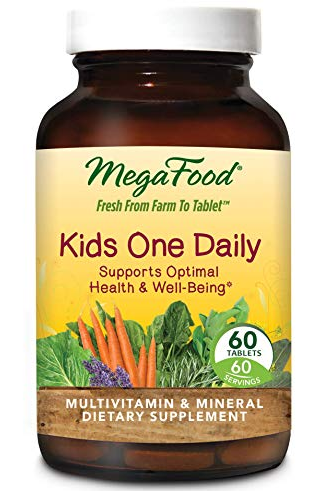
MegaFood Kids One Daily is a easy to use tablet that delivers all the vital nutrients your child needs and takes extra care to include trace elements that you won’t find in some other multivitamins for kids, such as selenium, boron, and copper.
MegaFood Kid’s One Daily also comes with added phytonutrients from oranges, cranberries, and blueberries to help boost antioxidant levels.
These added phytonutrients make it a great choice for kids who are picky eaters—while nothing can fully replace the benefits of whole fruits and vegetables, getting the antioxidant content can help reap at least some of the benefits. These extras make MegaFood Kids One Daily our number one pick.
2. Smarty Pants Kids Complete with Fiber

Smarty Pants Kids Complete with Fiber is a chewable multivitamin for kids delivers all of the essential vitamins and minerals your kid needs, plus some nice extras like omega 3 fatty acids from fish oil, and fiber from inulin and chicory root.
It’s iron-free, which makes it well-suited for young children, who have fairly low limits on iron intake. It’s free of artificial coloring and preservatives, and it’s sweetened only with lo han extract, a natural and sugar-free sweetener.
Smarty Pants is a great option for parents looking for a kids multivitamin that provides all the essentials in an all-natural package.
3. Garden of Life MyKind Organics Kids Multi

Garden of Life MyKind Organics Kids Multi uses organic ingredients to deliver one of the best gummy-based multivitamin for kids that’s on the market right now.
It’s iron-free and delivers all of the essential nutrients your child needs using natural plant ingredients, making it a great option for kids who don’t like to chew on a hard tablet for their daily multivitamin.
4. Garden of Life Vitamin Code Kids
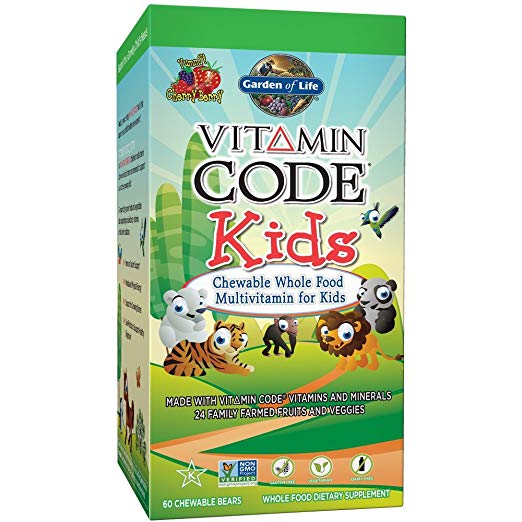
Vitamin Code is the flagship product of Garden of Life, which is known for its all-natural multivitamins. The kids version of its multivitamin delivers all the extras you’d expect from Garden of Life.
It has strong vitamin and mineral content, all derived from natural ingredients like beets, carrots, spinach, and blueberry, plus one billion CFUs of probiotics for better digestive health.
These probiotics are a rare find when it comes to children’s multivitamins, but they’re great for preventing digestive problems and for helping to restore the gut bacteria if your child has had to take antibiotics for strep throat or an ear infection.
The flavor isn’t the tastiest, but that might be helpful if you want to teach your kids that chewable vitamins aren’t candy.
5. Tropical Oasis Premium Kids Multivitamin
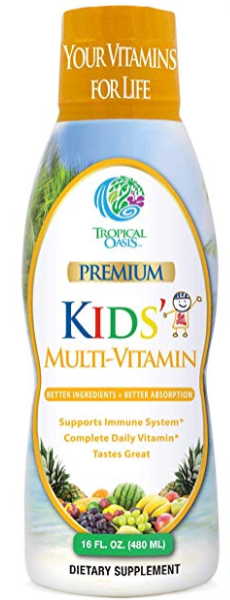
Tropical Oasis makes a multivitamin for kids that’s in a liquid form, which is the ultimate solution for kids who don’t deal well with tablets or gummies.
It’s free of sugar, but does use the sugar alcohol xylitol as a sweetener—not all parents are thrilled to have their kids taking non-caloric sweeteners, but Tropical Oasis Premium is still the best liquid kids multivitamin on the market.
6. Olly Kids Multi

Olly Kids Multi is a great option if your child doesn’t like traditional chewable tablets or has a hard time dealing with harder tablets.
These gummy vitamins are much easier on your teeth, and still deliver all the essential nutrients your child needs, plus omega 3 fatty acids.
However, the actual fish oil content is pretty low, so don’t count on this multivitamin to totally take care of your child’s healthy fat intake.
7. Naturelo Whole Food Vitamin Gummies
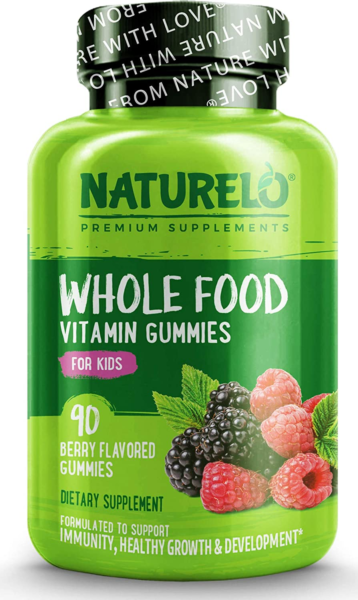
Naturelo takes a whole-food approach to this natural multivitamin gummy, and it’s got a fairly solid range of vitamins and minerals included. Compared to other competitors with the same approach (like Garden of Life), it comes up a bit short in terms of the variety of ingredients, though.
8. Nature’s Plus Source of Life Animal Parade
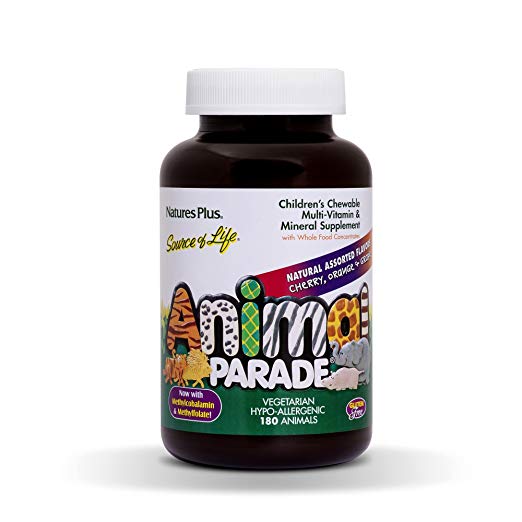
Nature’s Plus Source of Life Animal Parade is a comprehensive multivitamin that contains the usual vitamins and minerals you’d expect, plus extracts from pineapple and apple as natural sweeteners.
This multivitamin does contain iron, though at a fairly low dose (only 28% of the recommended daily intake), so do keep this in mind if you are trying to limit your child’s iron intake.
The sugar content (two grams per serving, all of it fructose) might be a turn-off for parents looking to keep sugar intake to an absolute minimum, but aside from the sugar, there are no other undesirable ingredients like coloring or flavoring agents.
9. Zarbee’s Naturals Children’s Complete Multivitamin

Zarbee’s Naturals makes a kid-friendly multivitamin that uses chewable gummies instead of hard tablets.
The nutrient content is solid, but you don’t get any additional perks or bonuses like probiotics or omega 3 fatty acids, and it does use both sugar and unspecified natural flavoring agents to enhance the taste of the gummies.
While it’s an okay pick, it gets edged out by its competitors on several fronts.
10. Nordic Naturals Nordic Berries

Famed for their high-quality fish oil supplements, Nordic Naturals also makes a multivitamin for kids.
Surprisingly, these gummy multivitamins do not include any omega 3 fatty acids, though they do supply 50% of the recommended daily intake for most of the essential vitamins and minerals.
While the nutrient quality is okay, the major drawback with this multivitamin for kids is the sugar content—at seven grams per serving, these gummies deliver quite a lot of sugar, which is not the best thing for your child’s development.
Category winners
Best multivitamin for kids overall: MegaFood Kids One Daily
MegaFoods takes the top spot overall thanks to its inclusion of the broadest range of vitamins and minerals, even including trace elements like boron and copper not found in other kids’ multivitamins. The independent purity testing only cements MegaFood’s place in the number one spot.
Best liquid multivitamin for kids: Tropical Oasis Kids’ Multi-Vitamin
Liquid multivitamins aren’t right for everyone, but if your child hates even chewable or gummy vitamins, Tropical Oasis is the way to go. While it’s flavored with sugar alcohols, it does provide solid amounts of a wide range of vitamins and minerals.
Best all-natural multivitamin for kids: Garden of Life Vitamin Code Kids
When it comes to all-natural supplements, Garden of Life is a heavyweight champ. Their Vitamin Code Kids supplement is no exception: it uses naturally-sourced ingredients like acerola cherry, kelp, beets, ginger, and garlic to provide all of the essential vitamins and minerals.
Best gummy multivitamin for kids: Garden of Life MyKind Organics Kids Multi
Gummy vitamins usually mean lots of synthetic colors, flavorings, and binders—not so with Garden of Life MyKind. It uses natural fruit purees and organic tapioca as a gummy base, and uses no synthetic colors or flavors.
Best multivitamin for kids with zinc: Garden of Life Vitamin Code Kids
Zinc is vital for optimal development, and while many kids’ multivitamins provide zinc, few source it naturally like Garden of Life. Code Kids uses brown rice chelate to provide all-natural zinc in a chewable supplement that’s both tasty and healthy.
Best multivitamin for kids with omega 3: Smarty Pants Kids Complete
Smarty Pants uses fish oil as a source for omega-3 fatty acids in their gummy vitamin, making it a great choice for parents concerned about optimal levels of the essential fatty acids EPA and DHA in their children.
Who should buy a multivitamin for kids?
If you have kids, you know that it’s not always easy to get them to eat healthy foods. While it’s definitely possible for a kid to get all of the nutrients they need from a healthy diet, whether you can get your child to adhere to a healthy diet all the time is another issue.
If you want to make sure your children are getting all the nutrients they need to develop properly, a multivitamin for kids is a great catch-all.
Why not just use a regular multivitamin for men or multivitamin for women? Children have different nutritional needs, and multivitamins for adults can have too much of some types of nutrients (like iron) and too little of others.
Plus, many kids have a hard time swallowing vitamins made for adults. For all of these reasons, a multivitamin for kids is a far better option if you are looking to ensure your child has optimal nutritional intake of all of the essential vitamins and minerals.
Children can start taking vitamins as early as six months of age. In fact, the National Health Service in the UK recommends that all children take a daily multivitamin starting at age six months to five years to ensure that kids develop properly.
Even as kids get older, maintaining proper nutrient intake is important for both physical and cognitive development. If a healthy diet isn’t consistently in reach, a multivitamin for kids is the next best option. When your child gets to age 12, you can switch over to an adult supplement, but until then a multivitamin for kids is a better idea.
How we ranked
To evaluate the overall quality of a multivitamin, we first made a comprehensive list of all of the multivitamin products on the market that are specifically formulated for kids.
We did not consider anything generic that was not specifically intended for children, as generic multivitamins are not formulated with the specific nutritional needs of children in mind.
As we’ll see later, these nutritional needs can be substantially different, and encompass some vitamins and minerals that should be provided at lower amounts, and some vitamins and minerals that should be provided at higher amounts, compared to a multivitamin for adults or a prenatal vitamin.
Once we identified kid-specific multivitamins, our first ranking criteria was the dosage of all the essential vitamins and minerals that kids need to develop. Unlike some other supplements, we did not give universally higher rankings to supplements that provided higher dosages.
More isn’t always better when it comes to vitamins and minerals, especially in kids. We also evaluated the multivitamins for kids differently on their iron content: while iron is an essential mineral for kids, it is also the leading cause of accidental poisoning in children. Kids can overdose on iron quite easily if they take several servings of an iron-containing multivitamin at once.
Because most kids get enough iron in their diet, on balance, our research team decided that kids multivitamins without iron are preferable in most cases to ones with iron. The risk-benefit payoff for most people tilts in favor of a multivitamin for kids that does not contain any iron.
In some cases, your pediatrician may recommend that your child take a multivitamin with iron in it. For people in this situation, we included a few of the best iron-containing multivitamins for kids, though they are lower in the rankings than the iron-free products.
Next, we took into account some aspects of supplement design that aren’t so important for adults—taste and texture. Often, kids have a hard time swallowing capsules whole, especially if they are large.
To this end, we ranked multivitamins for kids higher if they were chewable, as long as the formulation didn’t interfere with the efficacy of the supplement. We rated multivitamins higher if they had a good taste and a pleasant texture (some lower quality products can taste bitter or chalky).
At the same time, though, we wanted to ensure that good flavors, colors, and textures came from high quality ingredients, not from artificial colors and flavorings if it was avoidable.
Many health advocates are worried about the effects of artificial coloring agents on children, so we rated multivitamins higher if they used naturally derived sources, like black carrot or turmeric extracts, as opposed to synthetic coloring agents from a lab.
Liquid multivitamins present a special challenge: they’re great for kids who hate tablets, but they can be messy, and you can’t always measure out an exact dosage reliably.
We included a handful of the best liquid form multivitamins for kids in our rankings for niche cases where they’re the best option (like with kids who will spit out any chewable tablet), but they didn’t take the top spots in our rankings, as chewable tablets tend to have a better range of ingredients and fewer sweeteners and flavoring agents.
Finally, we sorted the remaining products by quality, which left us with our final rankings. We’re confident these are the best products on the market when it comes to multivitamins for kids. Whether you are looking for the best overall multivitamin, something with iron, or a liquid based supplement, you’ll find what you need in our rankings.
Benefits
Multivitamins provide the full range of essential vitamins and minerals. Multivitamins serve as catch-all supplements to make sure you are getting all of the necessary vitamins and minerals you need for optimal health, and multivitamins come in special formulations for men, women, and of course, children.
A multivitamin for kids requires different formulation than a multivitamin for adults, because the nutritional needs of children are not the same.
In addition to the challenge of getting the right nutrients, there is also the issue of kids being picky eaters. It can be hard to get a picky kid to finish his or her fruits and vegetables at meals, and moreover, most kids can’t take or don’t like usual capsule-based multivitamins.
As a result, kids multivitamins use one of three strategies: chewable tables, chewable gummies, or liquids. Regardless of the strategy, a high-quality multivitamin for kids will deliver the right vitamins and minerals in appropriate proportions for healthy growth and development.
Vitamin D and Vitamin A are particularly important for kids. While most of the critical vitamins that kids need, like vitamin K, are fortified into pre-prepared foods, scientific research has identified a few key vitamins that are often not supplied in sufficient amounts in children’s diets.
According to a scientific review article published in the Archives of Disease in Childhood in 2007, vitamins A and D may require supplementation in some children, particularly if they are not eating a healthy diet (1).
Vitamin D is a particular problem because it is not naturally found in almost any foods. It is usually synthesized in your body during exposure to direct sunlight, but in winter months, and for children with darker skin, vitamin D levels are often much lower than is optimal for health.
A lack of vitamin D in kids has been associated with diseases ranging from asthma to type 1 diabetes. Detailed nutritional investigations into children’s health supports the claim that vitamins D and A are of particular importance for children.
One study published in The Lancet in 2001 followed children in Finland, an area known to have a high rate of vitamin deficiency (2).
The study followed over 10,000 children from birth and examined whether vitamin D supplementation was associated with risk of developing type 1 diabetes.
The researchers found that children who had been given a supplement containing vitamin D on a regular basis were over eight times less likely to develop type 1 diabetes, even after adjusting for potentially confounding factors such as body mass and socioeconomic status.
Other research extends this same perspective to asthma—a scientific paper published in the American Journal of Respiratory and Critical Care Medicine in 2011 examined vitamin D status and severe asthma (3).
By testing the blood levels of vitamin D among children with and without asthma, the researchers were able to correlate higher vitamin D levels with better airway function.
Vitamin A is important for proper growth and vision. According to Stanford Children’s Hospital, appropriate levels of vitamin A in a child’s diet are essential for the proper development of skin, vision, and overall musculoskeletal growth (4).
One article estimated the prevalence of vitamin A deficiency across the Americas at approximately five percent, indicating that vitamin A intake might be an important feature to pay attention to in your child’s multivitamin (5).
Starting a multivitamin before age four could reduce the risk of developing food allergies. One fascinating study conducted by researchers in Stockholm, Sweden and published in 2009 in the American Journal of Clinical Nutrition suggests that there is a possible protective link between multivitamin supplements taken at an early age and the development of food allergies by age eight (6).
The study examined multivitamin use in early life among children with and without a range of allergies, and found that multivitamin use prior to age four (but not afterwards) seemed to have a protective effect on risk for developing food allergies.
Interestingly, other work has found the opposite trend among infants, so the link between multivitamin use and allergies is still an active area of research (7).
A multivitamin might help your child’s academic performance. Since vitamins and minerals are related to brain growth and development, it shouldn’t be a big surprise that a multivitamin might help with academic performance. A small randomized trial published in the Lancet in 1988 was able to show that a multivitamin supplement taken by a sample of 30 out of 90 school children age 12 to 13 years was able to boost academic performance when compared to a placebo supplement, or no supplement at all. While these results are from a small study, they’re still promising: if your child has nutritional deficiencies, a multivitamin might help boost academic performance.
Side effects
The primary side effects associated with multivitamin use is toxicity as a result of excessive consumption. Iron is particularly problematic; ingesting iron supplements is the most common reason children are seen at poison control centers (8).
Of course, iron is also a necessary mineral for children, but most kids who are not on a very picky vegetarian diet get a sufficient amount in their normal food.
Talking with your pediatrician about your child’s iron intake is a good strategy to determine whether you should get a multivitamin for kids with iron, or whether to opt for one without iron.
Recommended dose
Managing the appropriate dose of each individual vitamin and mineral is exceptionally difficult, which is the entire point of taking a single multivitamin in the first place.
With regards to dose, all high-quality multivitamins for kids will contain the right proportions of vitamins and minerals in each serving.
Keep an eye on the exact serving size, as it might be two or three tablets instead of just one. After giving your child his or her multivitamin, keep the rest of the bottle locked in a cabinet out of reach to make sure they don’t take any more—too much of some vitamins and minerals can be particularly toxic in children, as their bodies are much smaller than an adult’s.
FAQ
Q: Should my child take multivitamins?
A: While it is definitely possible to get all of the essential vitamins and minerals from a healthy diet, it’s not always easy to ensure that your child is getting a diet with all of the requisite nutrients, especially if you don’t have full control over your child’s diet (for example, with school lunches).
Many doctors recommend that children take a multivitamin, as does the National Health Service in the UK. If you’re unsure, you can always ask your child’s pediatrician if your child would need a multivitamin, and if your child has any particular nutritional needs beyond the usual vitamins and minerals.
Q: When can kids start taking multivitamins?
A: Children can start taking multivitamins as early as six months, according to the UK’s National Health Service, which recommends a multivitamin for all kids age six months to five years (9).
Younger kids might need to take liquid vitamins until they’re old enough to chew a chewable kids vitamin. As is always the rule with matters involving your child, you can ask your pediatrician for guidance if you’re not sure whether or not your child is ready to take a multivitamin.
Q: Should a multivitamin for kids have iron in it?
A: For most kids, you should get a multivitamin that does not have iron in it. Most kids, even toddlers, get enough iron in their typical diet. Moreover, kids can suffer from iron overdose if they take too many servings of a multivitamin that has iron in it.
An iron-free multivitamin reduces the risk of accidental poisoning from iron overdose, and this fact combined with knowing that children rarely have issues with iron intake in their diet means that, for most families, an iron-free multivitamin is the best choice. Your doctor can let you know if your child in particular would benefit more from a multivitamin that contains iron.
Q: What should you look for in a multivitamin for kids?
A: From a health perspective, the most important micronutrients to look for are vitamins A, C, and D, as these are some of the most common deficiencies (and are the hardest to get in a standard diet).
Vitamin D is particularly important if you live somewhere that has long winters, as vitamin D deficiency becomes increasingly common as you move further away from the equator (due to less sun exposure). You should be mindful of other supplements that you might be giving your child that might also have vitamin A in them, because of these three key vitamins, vitamin A is the easiest to overload on.
The most common alternative supplemental source of vitamin A is cod liver oil; experts recommend that you not give your child both a cod liver oil supplement and a multivitamin that contains vitamin A.
That’s because it is difficult for your body to get rid of extra vitamin A, since it is only soluble in fat, not water. The B complex vitamins are also important in a multivitamin for kids, as these supports proper development of the brain and the nervous system.
Q: When should you switch from a multivitamin for kids to a multivitamin for adults?
A: Multivitamins for kids are designed for at least through the first major growth spurt, so age twelve or so is a good crossover point for switching from a kid’s multivitamin to an adult multivitamin.
A good multivitamin for men or multivitamin for women is designed to support the kind of hormonal changes that happen during puberty, so age 12 is a good time to switch over. An adult vitamin will better support puberty once your child hits age 12.
Q: What’s the best multivitamin for kids age 10 and older?
A: Pretty much any of the top-ranked multivitamins on our list are great for kids under age 10. Our research team particularly liked MegaFood Kid’s One Daily, Smarty Pants Kids Complete, and The Honest Company Gummy Multivitamins thanks to their well-balanced iron-free formulation and clean supplement design.
If your child is very young, a liquid multivitamin supplement like Tropical Oasis might be a good alternative if chewable, gummy, or capsule based multivitamins aren’t a good fit for your child.
Q: Are Flintstones vitamins good for kids?
A: Flintstones Vitamins are extremely popular, but they did not make our rankings of the top multivitamins for kids because they have a lot of iron, and also contain a lot of artificial coloring agents, including Blue #2, Red #40, and Yellow #6 Lake.
There are better options on the market that don’t have iron (or have a lower dose, and thus pose a lower risk of accidental poisoning) and don’t have synthetic coloring agents. Because of these weaknesses, we don’t think Flintstones Vitamins are among the best options when it comes to multivitamins for kids.
Q: How do you get kids to take their multivitamins?
A: Parents often have a tough time getting their kids to take a multivitamin. If you can’t get your child to take a multivitamin, you might want to try something that’s better-tasting, like a gummy-based multivitamin for kids. If even that doesn’t work, you can try using a liquid based multivitamin instead.
These can be measured out in droppers and taken slowly, if your child can’t take a full dose all at once. One you make taking a vitamin a daily part of your child’s routine, it should become easier to get your kid to take their vitamins.
Related articles
- Prenatal vitamins
- Multivitamin for men
- Multivitamin for women
- Green superfood drinks
- Cod liver oil
- Fish Oil
Recap
A multivitamin for kids is a good way to ensure that your child is getting sufficient intake of all of the necessary vitamins and minerals needed for proper growth and development.
Scientific research has identified both vitamins A and vitamins D as frequent sources of deficiencies in children, so be sure to keep an eye on the vitamin A and D content of the multivitamin for kids that you choose.
Supplementing these and other vitamins and minerals appears to be linked to a lower risk of health problems that affect children, such as type 1 diabetes, asthma, and possibly even food allergies.
Be sure to follow the dosage directions on the label closely, and make sure your kids can’t get access to the multivitamin bottle. The primary side effects associated with multivitamins in kids are all linked to excessive intake of specific vitamins or minerals, and iron is the most common culprit. Many multivitamins have low or no iron to offset this risk.
Overall, a multivitamin for kids is a good way to ensure that even children who are picky eaters get the vitamins and minerals they need for appropriate growth, development, and health.
For BodyNutrition’s #1 recommended multivitamin for kids, click here.